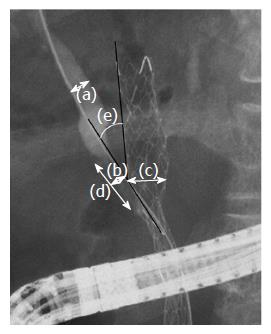Copyright
©The Author(s) 2017.
World J Gastroenterol. Sep 14, 2017; 23(34): 6273-6280
Published online Sep 14, 2017. doi: 10.3748/wjg.v23.i34.6273
Published online Sep 14, 2017. doi: 10.3748/wjg.v23.i34.6273
Figure 2 Endoscopic retrograde cholangiography image showing the details of the obstructive state of the biliary duct.
We evaluated the obstructive state of the biliary duct by measuring the following four items: (a) The diameter of the target biliary duct, (b) the diameter of the target biliary stricture, (c) the diameter of the first retained self-expandable metallic stent (SEMS), (d) the length of the target biliary duct stricture and (e) the angle between the target biliary duct stricture and the first implanted SEMS.
- Citation: Sugimoto M, Takagi T, Suzuki R, Konno N, Asama H, Watanabe K, Nakamura J, Kikuchi H, Waragai Y, Takasumi M, Sato Y, Hikichi T, Ohira H. Predictive factors for the failure of endoscopic stent-in-stent self-expandable metallic stent placement to treat malignant hilar biliary obstruction. World J Gastroenterol 2017; 23(34): 6273-6280
- URL: https://www.wjgnet.com/1007-9327/full/v23/i34/6273.htm
- DOI: https://dx.doi.org/10.3748/wjg.v23.i34.6273









